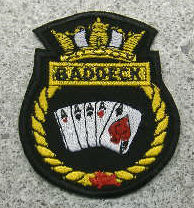
A hydrofoil is a lifting surface, or foil, that operates in water. They are similar in appearance and purpose to aerofoils used by aeroplanes. Boats that use hydrofoil technology are also simply termed hydrofoils. As a hydrofoil craft gains speed, the hydrofoils lift the boat's hull out of the water, decreasing drag and allowing greater speeds.

Bras d'Or Lake is an irregular estuary in the centre of Cape Breton Island in Nova Scotia, Canada. It has a connection to the open sea, and is tidal. It also has inflows of fresh water from rivers, making the brackish water a very productive natural habitat. It was designated the Bras d'Or Lake Biosphere Reserve by UNESCO in 2011.

The Pegasus-class hydrofoils were a series of fast attack patrol boats employed by the U.S. Navy. They were in service from 1977 until 1993. These hydrofoils carried the designation "PHM" for "Patrol, Hydrofoil, Missile." The Pegasus-class vessels were originally intended for NATO operations in the North Sea and Baltic Sea. Subsequently, participation by other NATO navies, including Germany and Italy, ceased and the U.S. Navy proceeded to procure six PHMs, which were highly successful in conducting coastal operations, such as narcotics interdiction and coastal patrol, in the Caribbean basin.
Protector(s) or The Protector(s) may refer to:
Marine Industries Limited (MIL) was a Canadian ship building and rail car manufacturing company, in Sorel-Tracy, Quebec, with a shipyard located on the Richelieu river about 1 km from the St. Lawrence River. It employed up to 10,000 people during the post World War II boom.

HMCS Preserver was a Protecteur-class auxiliary oiler replenishment of the Royal Canadian Navy commissioned in 1970. Built at Saint John, New Brunswick and launched in 1969, the vessel took part in several overseas deployments, including Operation Deliverance, which became better known as the Somalia Affair. The ship underwent a major refit in 2005, after she was plagued by electrical problems. With these difficulties unresolved, Preserver was withdrawn from sea-going service in 2014 and was paid off on 21 October 2016. The vessel was broken up for scrap at Sydney, Nova Scotia in 2017.

HMCS Bras d'Or was a hydrofoil that served in the Canadian Forces from 1968 to 1971. During sea trials in 1969, the vessel exceeded 63 knots, making her the fastest unarmed warship in the world at the time.

USS Plainview (AGEH–1) was, in its time, the world's largest hydrofoil. Named for the cities of Plainview, New York and Plainview, Texas. She was also the United States Navy's first hydrofoil research ship. Plainview was designed under project SCB 219; laid down 8 May 1964 by the Lockheed Shipbuilding and Construction Company, Seattle, Washington; launched 28 June 1965; sponsored by Mrs. John T. Hayward; and placed in service on 3 March 1969. She cost $21 million to construct.
The Royal Canadian Navy uses hull classification symbols to identify the types of its ships, which are similar to the United States Navy's Hull classification symbol system. The Royal Navy and some European and Commonwealth navies use a somewhat analogous system of Pennant numbers.
Several Canadian naval units have carried the name HMCS Champlain:

The Sparviero-class, also known as Nibbio-Class, are small hydrofoil missile boats capable of traveling at speeds of 46 knots. They were designed for and formerly used by the Italian Navy. The Japanese 1-go class missile boat is an updated version formerly used by the Japan Maritime Self-Defense Force (JMSDF).

The Matka class is the NATO reporting name for a group of hydrofoil missile boats built for the Soviet Navy. The Soviet designation is Project 206MR Vikhr. Following the 1997 Black Sea Fleet partition treaty all Black Sea Fleet Matka class boats were passed to the Ukrainian Navy.

The Sarancha class is the NATO reporting name for a hydrofoil missile boat built for the Soviet Navy. The Soviet designation was Project 1240 Uragan.
Bras d'Or Lake, the name of which means arms of gold or golden arms, is a saltwater lake on Cape Breton Island.
Bras d'Or (R-103) was a small experimental hydrofoil built for the Royal Canadian Navy (RCN) during the 1950s. It led to the development of HMCS Bras d'Or (FHE 400) in the late 1960s.
Baddeck, Nova Scotia is a village founded in 1908, with a history stretching back to early Mi'kmaq, French and British settlements. The village was home to Alexander Graham Bell and was witness to the first flight in the commonwealth with Bell's Silver Dart.

HMCS Baddeck is a name used by the Royal Canadian Navy for several vessels. The name derives from Baddeck, Nova Scotia.

HD-4 or Hydrodome number 4 was an early research hydrofoil watercraft developed by the scientist Alexander Graham Bell. It was designed and built at the Bell Boatyard on Bell's Beinn Bhreagh estate near Baddeck, Nova Scotia. In 1919, it set a world marine speed record of 70.86 miles per hour (114.04 km/h).
HMCS Bras d'Or was an auxiliary minesweeper that served in the Royal Canadian Navy (RCN) between 1939 and 1940, when she sank with all hands in a storm. Previous to her service in the RCN, she served as Lightship No. 25 in the Canadian Department of Marine and Fisheries.

The Experimental Craft Hydrofoil No. 4 (XCH-4) was a high speed hydrofoil of the United States Navy. In 1947 the Bureau of Ships in association with the Office of Naval Research subsidised the construction of a number of small watercraft to explore several different types of foils and foil control-system configurations. The XCH-4 was designed by John H. Carl and built, in 1953, by Dynamic Developments Inc., a former associate of the Grumman Aircraft Engineering Corporation.










